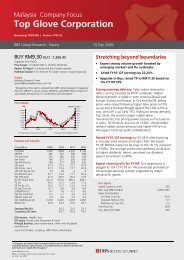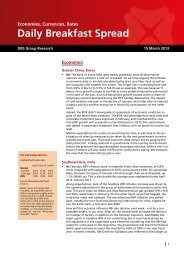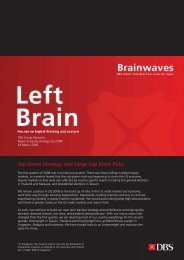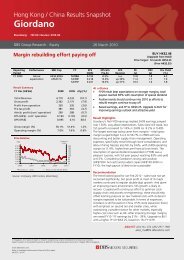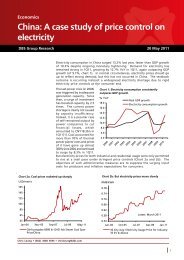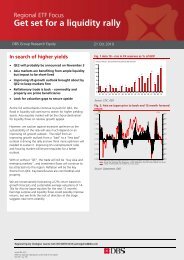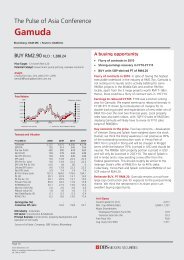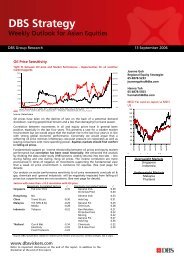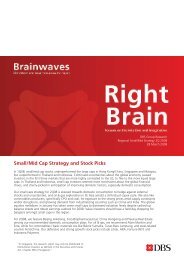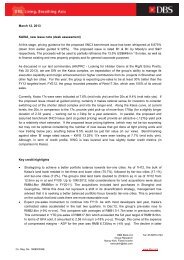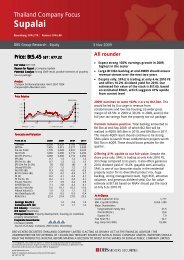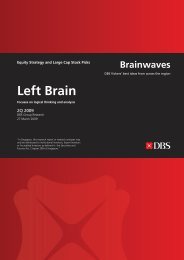Left Brain Right B - the DBS Vickers Securities Equities Research
Left Brain Right B - the DBS Vickers Securities Equities Research
Left Brain Right B - the DBS Vickers Securities Equities Research
Create successful ePaper yourself
Turn your PDF publications into a flip-book with our unique Google optimized e-Paper software.
Regional Equity Strategy 4Q 2009<br />
Strategy Overview: Asia Equity<br />
India: Risks remain (Ramya Suryanarayanan, ramya@dbs.com, extracted from “Economics – Markets – Strategy,<br />
4Q09” dated 17 September 2009)<br />
• The economy is rebounding faster than expected, led<br />
by manufacturing<br />
• But drought like conditions lead us to trim FY09 GDP<br />
growth expectations to 5.7%. We have raised FY10<br />
growth to 7.5% from 6.9%<br />
• At projected sub-8% growth rates, we do not expect<br />
price pressures to intensify for a while. But<br />
expectations of higher prices will form and we expect<br />
200bps of rate hikes in 2010.<br />
• Wider deficits raise risks to economic and financial<br />
stability. Higher than expected inflation could also<br />
arise from <strong>the</strong>se imbalances<br />
• We maintain <strong>the</strong> view that a ratings downgrade is<br />
possible. The longer term consequence of <strong>the</strong> higher<br />
deficit could be higher inflation followed by<br />
monetary tightening. Higher rates could “crowd<br />
out” private sector investment and is a negative for<br />
<strong>the</strong> long-term growth outlook<br />
GDP review and outlook<br />
The non-agricultural economy is rebounding faster than<br />
expected, led by <strong>the</strong> manufacturing sector. At <strong>the</strong> same time,<br />
<strong>the</strong> agriculture sector is facing a setback from <strong>the</strong> drought-like<br />
conditions in nearly half of <strong>the</strong> country. While it is clear that<br />
<strong>the</strong> spectre facing <strong>the</strong> agriculture sector is temporary, <strong>the</strong><br />
bigger question is if <strong>the</strong> recovery in manufacturing is durable.<br />
Our take is that pent up demand is in part driving <strong>the</strong> rise in<br />
consumer demand, and consumption is o<strong>the</strong>rwise not on a<br />
solid footing. At <strong>the</strong> same time, supply side constraints - partly<br />
temporary and partly structural (such as infrastructure) - appear<br />
to be pushing prices higher in <strong>the</strong> interim. We believe this<br />
would have to be dealt with by <strong>the</strong> removal of policy<br />
accommodation to prevent inflation expectations from<br />
hardening.<br />
All told, while we pencil in faster non-agricultural GDP growth<br />
than a quarter ago, a sustainable return to 8-9% growth rates<br />
is not envisaged in <strong>the</strong> near-term. At <strong>the</strong> same time, <strong>the</strong> wider<br />
fiscal deficit announced in <strong>the</strong> July budget has fur<strong>the</strong>r<br />
worsened <strong>the</strong> risk profile of <strong>the</strong> economy.<br />
Assuming a 2% drop in agriculture GDP as a result of <strong>the</strong> circa<br />
20% deficiency in <strong>the</strong> monsoon, <strong>the</strong> direct hit on GDP from<br />
<strong>the</strong> drought works to a 0.4%-pt reduction in overall GDP<br />
growth. We do not expect any material indirect effect on<br />
consumer demand from <strong>the</strong> drought.<br />
What about prices ?<br />
Constraints on <strong>the</strong> supply side and pressures from high food<br />
prices have led to 5-7% (MoM, saar) rise in prices since<br />
Mar09. While we expect <strong>the</strong> price increase to moderate to<br />
circa 5% (MoM, saar) in <strong>the</strong> months ahead, <strong>the</strong> pace of rise in<br />
prices clearly is at odds with <strong>the</strong> apparently sub-potential rate<br />
of economic growth.<br />
At <strong>the</strong>se growth rates, we do not expect price pressures to<br />
intensify like <strong>the</strong>y did in 2007 or first half of 2008. However, a<br />
removal of policy accommodation is warranted to prevent<br />
inflation expectations from hardening. This is especially so after<br />
<strong>the</strong> 5% rise in dearness allowance sanctioned last week to<br />
central government employees.<br />
Consequently, we expect 150bps of repo and reverse repo rate<br />
hikes from Jan-June 2010 and ano<strong>the</strong>r 50bps of rate hikes in<br />
July-Dec 2010. This should take <strong>the</strong> repo rate to 6.75% and<br />
reverse repo rate to 5.25% by Dec10. In addition, cash reserve<br />
ratio (CRR) hikes would likely kick in simultaneously or ahead<br />
of rate hikes to assist in withdrawal of liquidity and clamp<br />
credit growth directly.<br />
Risks assessment<br />
We believe risks to economic and financial stability remain<br />
significant especially after <strong>the</strong> July budget has revealed a<br />
greater than expected fiscal deficit projection (6.8% of GDP),<br />
and that even after optimistic revenue assumptions. We expect<br />
<strong>the</strong> national fiscal balance to register a deficit of close to 10%<br />
of GDP in FY09, over 1%-pt wider than <strong>the</strong> government’s<br />
estimates, as commodity prices rise. Ratings agencies are<br />
waiting at present for <strong>the</strong> 13th Finance Commission report out<br />
late October for <strong>the</strong> government’s long-term strategy for fiscal<br />
consolidation. We maintain <strong>the</strong> view that a ratings downgrade<br />
is a real risk. The longer term consequence of <strong>the</strong> higher deficit<br />
- in a benign scenario, as is our core scenario - might manifest<br />
in higher inflation followed by higher rates. This, of course,<br />
would point to a crowding out of private sector as a result of<br />
<strong>the</strong> government’s fiscal profligacy. This is <strong>the</strong> ultimate risk lying<br />
ahead for <strong>the</strong> economy.<br />
Page 36<br />
“This report has been re-printed with permission from <strong>DBS</strong> Group <strong>Research</strong><br />
(Regional Equity Strategy) of <strong>DBS</strong> Bank Limited” disclosures on page 37 of this report



